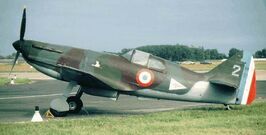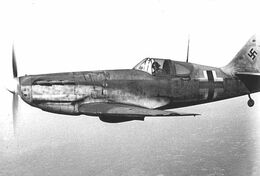The Dewoitine D.520 was a single-seat French fighter used during World War II.
Description[]
First designed in 1936, It had a wingspan of 10.2 meters and was armed with a 20 mm Hispano-Suiza HS.404 cannon and 4 7.5 mm machine guns. The D.520 entered service in 1940, fighting the Battle of France. After the country's defeat, it continued to be produced, and was used by both Vichy and Free French forces, as well as Germany, Italy, Bulgaria and Romania.[3]
History[]
Development and Testing[]
A development of the Dewoitine 500 and 510 with retractable undercarriage, the first prototype of the D.520 - fitted with an open cockpit - made its first flight on October 2nd 1938, only to be put out of action by a wheels up landing by Test pilot Marcel Doret on 2th November.[3] Originally fitted with a 12Y-21 engine driving a two bladed fixed pitch propeller, the prototype later received a12Y-29 engine and three blade propeller, while the twin under wing radiators were replaced by a single unit under the fuselage.[4]
A second prototype, with redesigned tail unit, cockpit canopy, strengthened undercarriage and armament, made its first flight on 28 January 1939, which resulted in an order for 200 examples, to be delivered by the end of the year, being placed on 17 April 1939. Subsequent orders in June and September 1939, and January, April and May 1940, resulted in total orders, including 120 for the Aeronavele, for 2,200 aircraft.[4]
Sub variant[]
As the Hispano Suiza 12Y engine was also used by other combat types, the French government made plans to cope with any shortfall in supply by fitting the later examples of the D.520 with Rolls Royce Merlin III engines as the D.521, beginning with the 251st aircraft. Work on the first D.521 continued after these plans were cancelled, with the only D.521 flying for the first time on 9th February 1940. Intended to carry an armament of two HS 20mm autocannon and four MAC 34 machine guns, the D.521 suffered poor low speed stability and cg difficulties caused by the heavier Merlin engine. The D.521 was grounded after six test flights, and fitted with a 1,200 hp HS 12Z engine as the D.524, but development of this new type was cancelled following the Armistice.[5]
Operational Service[]
Armee de l'Air/Free French Air Forces[]

A French Air Force D.520.
The first unit to take the D.520 into action was GC (Groupe de Chasse = Fighter Group) I/3, followed in late May 1940 by GC II/3. III/3, III/6 and I/7 also went into action with the type. These groups were credited with 147 victories for the loss of 85 aircraft and 44 pilots before the capitulation.[3] on June 17th 1940,[6]
Following the liberation of Southern France in mid 1944, the Groupe Doret was formed with D.520s, participating in attacks against remaining units of the Wehrmact. This unit was redesignated GC II/18 'Saintonge' following the formal reconstitution of the French Air Force on 1 December 1944, and issued with 15 D.520s. When GC II/18 re-equipped with Spitfire VBs, The D.520s were shared between GCB I/18 'Vendee' and an unnamed training unit at Toulouse. During the final months of the war, some 50 D.520s recovered from the Germans were added to approximately 20 aircraft brought back from North Africa.
A dozen aircraft were fitted with a second cockpit for training purposes.[4]
Vichy France[]
On 15 May 1941 British forces carried out air attacks against the airbases at Palmya, Rayack, Damascus, Homs, Tripoli and Beirut, prompting The Vichy government to dispatch the D.520s of Groupe de Chasse III/6 to Rayak, in the French mandated Levant region, to supplement the aircraft already stationed there. [7] During the British invasion of the Levant on 8th June, an attack against Rayak by RAF Hurricanes and RAAF Tomahawks led to one D.520 being burnt and another seven being damaged.[8]
By the time of the Allied invasion of North-West Africa in November 1942, the Vichy regime possessed 427 D.520s - 234 in France, 173 in North Africa and 20 in West Africa [9]
Germany[]

A Luftwaffe D.520.
In 1942, the Germans seized 411 examples, passing many to Italy, Romania and Bulgaria, [3] while retaining 50 for use as advanced trainers with JG 101 and JG 105 in France and JG 103 in Austria. This led to heavy losses as the D.520 was very different to German aircraft of the period, [9]especially in regard to the throttle lever, which worked differently in French and Italian aircraft of the period.[10]
Italy[]
The Regia Aeronautica received at least 60[9] and possibly as many as 72[2] D.520 aircraft from Germany in November 1942, using them as second line fighters for the defence of Naples, serving with single squadrons of the 13, 22 24 and 167 Gruppo, [11] and as fighter trainers. [9] 30 examples were transferred to Germany in exchange for captured LeO 451 bombers.[2]
Bulgaria[]
Received at least 96[2] and possibly as many as 150[9] D.520 aircraft for front line fighter duty, with the first arriving in August 1943, while the pilots were training with JG 107 at Nancy.[12] 48 D.520s were taken over by Bulgaria in a ceremony at Karlovo airfield in early September 1943.[13]
Bulgaria's D.520s first went into action on 24th November, when 24 examples took of from Vrashdebna, and joined 16 Bf 109G-2s operating from Bojourishte, in response to a raid by B-24 bombers of the 15th USAAF, which were sent to attack the Bulgarian capital Sofia, together with an escort force of 35 P-38 fighters.[13]
The next raid on 10th December saw 31 B-24s attack Sofia while escorted by P-38s. The 39 Bulgarian fighters sent to intercept the raid included 22 D.520s - 6 from II/6th Fighter regiment at Vrashdebna, and 16 from I/6th Fighter Regiment at Karlovo.[13] The Americans claimed 11 D.520s were shot down for the loss of 1 P-38 - in fact only 1 D.520 was lost.[14]
Following further raids against Sofia during January, February and March 1943, the Allies launched a heavy attack on 30 March which was met by a force of 73 fighters, including 34 D.520s.[15]
By 28th September 1944, only 17 D.520s remained on the strength on I Group, 6th Fighter Regiment of the Bulgarian Air Force, of which 12 were operational.[16]
Romania[]
Stated to have received up to 150 D.520 aircraft following the German occupation of Vichy France in November 1942.[2][N 1]
References[]
Notes[]
Sources[]
- ↑ World Aircraft Information Files File 892 Sheet 25 (A-Z of Aircraft:Dewoitine D.510 (continued) to Dorand AR.1 and AR.2
- ↑ 2.0 2.1 2.2 2.3 2.4 2.5 Green, William and Gordon Swanborough. Page 182.
- ↑ 3.0 3.1 3.2 3.3 Gunston, Bill. Illustrated Directory of Fighting Aircraft of World War II. Salamander Books. 1988. ISBN 0-86101-390-5 Pages 10-11
- ↑ 4.0 4.1 4.2 World Aircraft Information Files Aviation Partwork. Midsummer Books Ltd. File 84 Sheet 1 (World Military Aircraft: Dewoitine D.520 - Wartime Chasseur)
- ↑ Green, William and Gordon Swanborough. Complete Book of Fighters. Salamander Books. 2001. ISBN 1-84065-269-1 Page 183.
- ↑ Gunston, Bill (Forward). Jane's Fighting Aircraft of World War II. Tiger Books. 1989. ISBN 1-85501-996-5. (Reprint of Jane's All The World's Aircraft 1945/1946. Bridgeman, Leonard (Editor). 1946). Page 153
- ↑ Guttman, Jon. Fighting Firsts - Fighter Aircraft Combat Debuts fro 1914-1944. Cassell & Co. 2000. ISBN 1 85409 443 2 Page 153.
- ↑ Guttman, Jon. 2000, Page 154.
- ↑ 9.0 9.1 9.2 9.3 9.4 Take Off Issue 87 Aircraft Reference File - Axis Trainers of World War II
- ↑ Neulen, Hans Werner. In the Skies of Europe - Air Forces allied to the Luftwaffe 1939-1945. The Crowood Press. 2000. ISBN 1-86126-326-0 Page 240
- ↑ Take Off Issue 70 Aircraft Reference File - Italian Fighters of World War II
- ↑ Neulen, Hans Werner. 2000. Page 162
- ↑ 13.0 13.1 13.2 Neulen, Hans Werner. 2000. Page 163
- ↑ Neulen, Hans Werner. 2000. Page 164
- ↑ Neulen, Hans Werner. 2000. Page 166
- ↑ Neulen, Hans Werner. 2000. Page 168
| |||||||||||||||||||||||||||||||||||||||||
